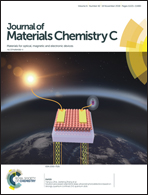Efficient flash memory devices based on non-conjugated ferrocene-containing copolymers†
Abstract
A series of non-conjugated ferrocene-containing copolymers FcCP1–FcCP3 with a triphenylamine (TPA), benzothiazole (BT) or phenothiazine (PHZ) unit has been designed and synthesized via a facile radical polymerization protocol. The structural, photophysical, electrochemical and memory characteristics of these polymers were systematically studied. All the copolymers exhibited flash memory behaviour with a bistable conductive process, where FcCP1 showed a large ON/OFF current ratio of 103 to 104 with a low threshold voltage of −0.6 V. Such remarkable results suggest that non-conjugated ferrocene-containing copolymers are promising active materials for memory applications.



 Please wait while we load your content...
Please wait while we load your content...